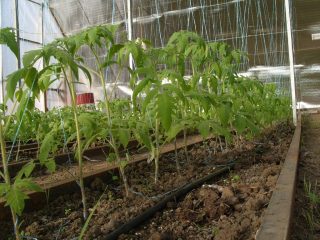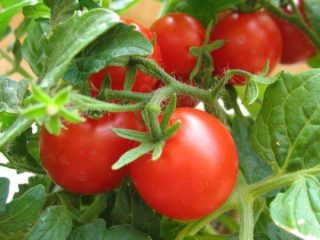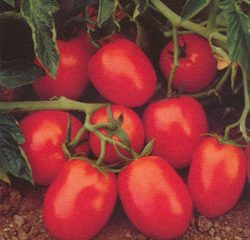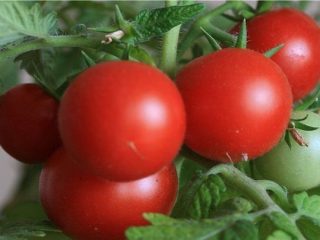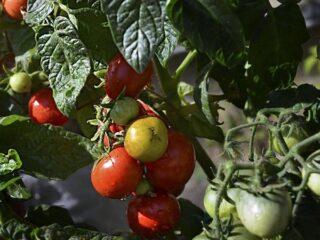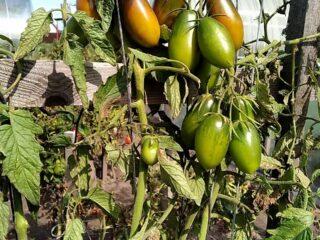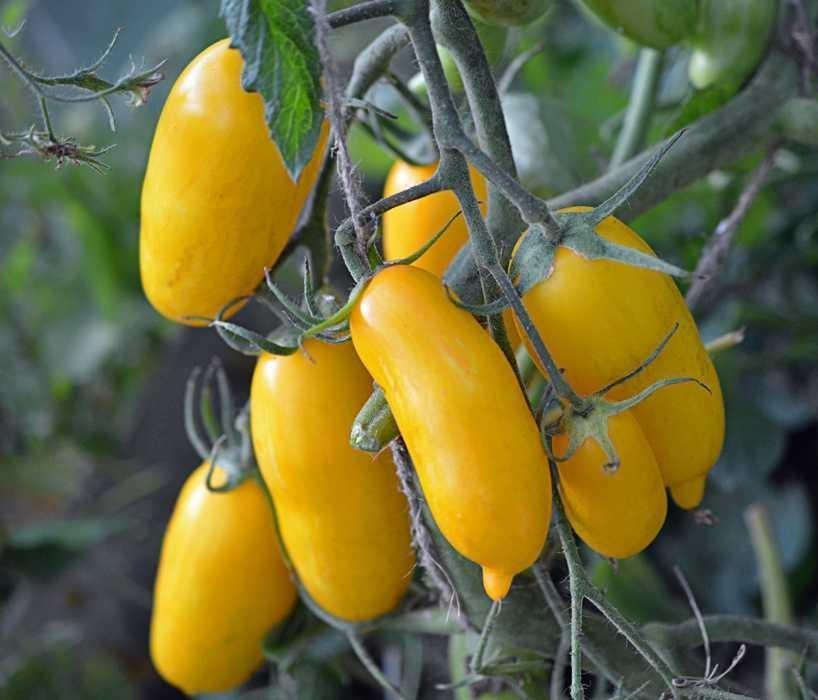Content
- 1 Who brought it out and when?
- 2 Description of tomatoes variety Children's Joy
- 3 Characteristics of the tomato Children's joy
- 4 Advantages and disadvantages
- 5 Planting seedlings and transplanting into the ground
- 6 Tomato care Children's joy
- 7 Treatment against diseases and pests
- 8 Conclusion
- 9 Reviews from gardeners about cherry tomatoes Children's joy
Tomato Children's Joy is an early ripening hybrid variety of Russian selection, characterized by high yield and extended fruiting. It is valued for its versatility and excellent taste qualities of the fruit and is suitable for growing in film greenhouses.
Who brought it out and when?
The Child's Joy tomato was bred in the early 2000s by employees of the Russian agricultural company Sedek, whose assortment includes over 2,000 varieties and hybrids of flower and vegetable crops. A whole group of breeders worked on its creation, which included I. Dubinina, S. Dubinin and A. Lukyanenko.
Description of tomatoes variety Children's Joy
The plant is a tall bush of indeterminate type. Its thin shoots stretch up to 2 m, covered with a few medium-sized green leaves.

The first inflorescence is laid above the ninth leaf, and 12-16 tomatoes are formed on each cluster
During the fruiting period, the bush produces small, round fruits with dense, sweet and sour pulp. They weigh 20-30 g and are covered with a strong, smooth skin, the color of which depends on the degree of ripeness of the tomatoes. Unripe tomatoes are green with a spot; ripe fruits become bright red.
Characteristics of the tomato Children's joy
Tomato Children's Joy is a relatively new and very promising variety, suitable for growing on an industrial scale. It is valued for its early ripening and long, stable fruiting, lasting until autumn.
Ripening time
Tomato Children's Joy is classified as an early ripening variety. It begins to bear fruit 95-105 days after emergence and already in July pleases with ripe tomatoes.
Tomato yield Children's joy
The variety is classified as highly productive. The average yield of the Child's Joy tomato is 5.1-5.7 kg/m2.
Disease resistance
The Child's Joy tomato is characterized by good immunity and is resistant to some “tomato” diseases. In particular, the variety is immune to fruit blossom end rot, verticillium and fusarium.
In what regions is it grown?
The Child's Joy tomato is recommended for cultivation in the Far Eastern, East Siberian, West Siberian, Ural, Lower Volga, Middle Volga, North Caucasus, Volga-Vyatka, Central, Central Black Earth, Northwestern and Northern regions. In Siberia and central Russia and Siberia, these tomatoes are best grown in film greenhouses.
Purpose and application
The Child's Joy tomato is classified as a universal variety such as cherry. Its small, round fruits have a pleasant sweet and sour taste and are widely used in cooking. They are consumed raw, pickled and frozen. They are also used to prepare various vegetable salads, purees, ketchups, sauces and juices.

Due to their small size, Children's Joy tomatoes are suitable for whole-fruit canning
Advantages and disadvantages
The Child's Joy tomato is a high-yielding hybrid characterized by low maintenance and rapid fruit ripening. It is a universal variety and is successfully grown throughout almost the entire territory of the Russian Federation.

The dense skin reliably protects the fruits from damage, so they tolerate transportation well
Pros:
- pleasant taste;
- earlier maturation;
- transportability;
- high productivity;
- extended fruiting;
- resistance to diseases.
Minuses:
- need for tying;
- impossibility of growing from collected seeds.
Planting seedlings and transplanting into the ground
The Child's Joy tomato is grown using the seedling method, mainly in protected ground. In March, tomato seeds are sown in suitable plastic containers filled with moist purchased soil substrate or a mixture of equal amounts of sand, peat and garden soil. Before planting, they are immersed in a weak solution of potassium permanganate (1 g/100 ml of water) for 25-30 minutes, washed and soaked in a growth stimulator for at least 30-40 minutes. Treated seeds are buried to a maximum of 20 mm and covered with glass or transparent film to ensure a greenhouse effect.
When the first shoots hatch, the film or glass is removed from the container, and the ambient temperature is slightly reduced. After several true leaves are formed on the plants, they are transplanted into individual plastic cups. The seedlings are regularly watered and fed with liquid complex fertilizers before being transferred to a permanent place.

Planting tomato seedlings Children's Joy is carried out according to the 50×70 cm pattern
Transplantation is carried out approximately two months after sowing the seeds, when the first cluster forms on the plants. Do not keep the seedlings on the windowsill longer so that they do not overgrow. In a bed with fertile soil, dig holes so that 1 m2 there were a maximum of four bushes. The seedlings are carefully removed from the cups, trying not to disturb the earthen ball, and planted in the prepared holes. Finally, the plantings are watered with cool, settled water and provided with reliable support.
Tomato care Children's joy
Although the Child's Joy tomato is undemanding in care, to obtain the declared productivity and improve the taste characteristics of the fruit, summer residents will have to follow the basic rules of agricultural technology, which include:
- Watering. The soil under the tomato bushes is moistened on average once a week, focusing on the current condition of the soil. For irrigation, use non-cold, settled water. It is poured strictly at the root at the rate of 10 l/m2 before fruiting and 20 l/m2 from the moment it began.
- Fertilizer application. Tomatoes are fed 3-5 times per season. During the period of active growth, phosphate or nitrogen-containing fertilizers are applied to the soil. Later, the plants are fed with organic matter, complex and mineral compounds.
- Soil treatment.1-2 days after each watering, the soil under the tomatoes is loosened to ensure the flow of oxygen to the roots and prevent stagnation of moisture, which provokes the development of fungal diseases. Also, the tree trunk circle is weeded to remove weeds that absorb water and nutrients from the soil.
- Formation of plants. Bushes are formed into 1-2 stems, promptly tearing off wilted leaves, dried out shoots and excess shoots. The plates growing in the lower part of the bush are removed gradually - no more than a couple of pieces at a time, so as not to provoke cracking of the fruit. The leaves are torn off until all specimens growing below the first fruit cluster are removed. To support the shoots, the tomatoes are tied to a trellis with soft twine, wrapping the stem under each internode. At the same time, they get rid of stepsons - shoots growing from the axils of the leaves.
- Hilling. Tomatoes form additional roots that have to be covered with soil. Bushes are earthed twice per season: when root buds form on the shoots near the surface of the soil and after the lower part of the stem turns slightly blue.
Treatment against diseases and pests
Although the Child's Joy tomato is resistant to major tomato diseases, in cold rainy weather it is easily affected by late blight, better known as brown rot. This rapidly progressing fungal infection affects all parts of the plant, including the fruit, and can destroy up to 70% of the crop. It develops as a result of infection with the fungus Phytophthora infestans, the spores of which persist in the soil for a long time. For the prevention and treatment of late blight, fungicides are used, for example, Fitosporin, Healer, Ridomil Gold, etc.

The root system of plants is the first to suffer from late blight, after which the disease spreads to the foliage and fruits
Conclusion
Tomato Children's Joy is a popular hybrid variety bred by Russian breeders. It is characterized by good immunity and produces ripe, sweet and sour tomatoes from July to September.
Reviews from gardeners about cherry tomatoes Children's joy
